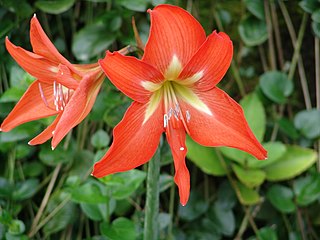
Hippeastrum is a genus of about 90 species and over 600 hybrids and cultivars of perennial herbaceous bulbous plants. They generally have large fleshy bulbs and tall broad leaves, generally evergreen, and large red or purple flowers.
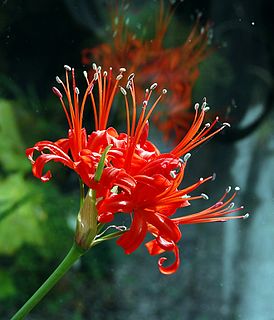
Nerine is a genus of flowering plants belonging to the family Amaryllidaceae, subfamily Amaryllidoideae. They are bulbous perennials, some evergreen, associated with rocky and arid habitats. They bear spherical umbels of lily-like flowers in shades from white through pink to crimson. In the case of deciduous species, the flowers may appear on naked stems before the leaves develop. Native to South Africa, there are about 20–30 species in the genus. Though described as lilies, they are not significantly related to the true lilies (Liliaceae), but more closely resemble their relatives, Amaryllis and Lycoris. The genus was established by the Revd. William Herbert in 1820.
Botanical nomenclature is the formal, scientific naming of plants. It is related to, but distinct from taxonomy. Plant taxonomy is concerned with grouping and classifying plants; botanical nomenclature then provides names for the results of this process. The starting point for modern botanical nomenclature is Linnaeus' Species Plantarum of 1753. Botanical nomenclature is governed by the International Code of Nomenclature for algae, fungi, and plants (ICN), which replaces the International Code of Botanical Nomenclature (ICBN). Fossil plants are also covered by the code of nomenclature.
The Hon. William Herbert was a British botanist, botanical illustrator, poet, and clergyman. He served as a member of parliament for Hampshire from 1806 to 1807, and for Cricklade from 1811 to 1812. His botanical writings are noted for his treatment of Amaryllidaceae.

A bulbil is a small, young plant that is reproduced vegetatively from axillary buds on the parent plant's stem or in place of a flower on an inflorescence. These young plants are clones of the parent plant that produced them—they have identical genetic material. The formation of bulbils is a form of asexual reproduction, as they can eventually go on to form new stand-alone plants.
Sydney Percy-Lancaster, F.L.S., F.R.H.S., M.R.A.S. was born on 19 July 1886 at Meerut, India. His father, Percy Lancaster, was a banker and a talented amateur gardener, who went on to become the Secretary of the Agri Horticultural Society of India in Calcutta, India.
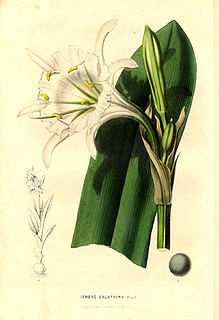
Ismene, or Peruvian daffodil, is a genus of South American plants in the Amaryllis family. The species are native to Peru and Ecuador and widely cultivated elsewhere as ornamentals because of their large, showy flowers.
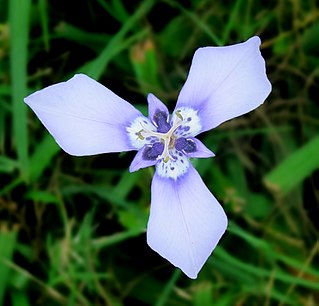
Herbertia is a small genus of herbaceous, perennial and bulbous plants in the Iris family (Iridaceae).
Brian Frederick Mathew MBE, VMH is a British botanist, born in the village of Limpsfield, Surrey, England. His particular area of expertise is bulbous plants, particularly ornamental bulbous plants, although he has contributed to other fields of taxonomy and horticulture. He has authored or co-authored many books on bulbs and bulbous genera which appeal to both botanists and gardeners, as well as specialist monographs on other genera, including Daphne, Lewisia, and Helleborus. His work has been recognized by the British Royal Horticultural Society and the International Bulb Society.

The Alpine Garden Society is a society based in the United Kingdom, with its headquarters at Pershore, Worcestershire. It describes itself as an "International Society for the cultivation, conservation and exploration of alpine and rock garden plants, small hardy herbaceous plants, hardy and half-hardy bulbs, hardy ferns and small shrubs".
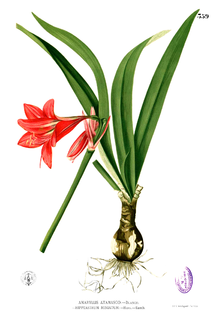
Hippeastrum miniatum is a flowering perennial herbaceous bulbous plant, in the family Amaryllidaceae, native to Peru.

Hippeastrum psittacinum is a flowering perennial herbaceous bulbous plant, in the family Amaryllidaceae, native to Brazil.
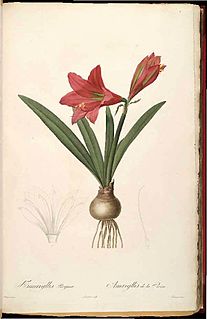
Hippeastrum petiolatum is a flowering perennial herbaceous bulbous plant, in the family Amaryllidaceae, native to Venezuela, Bolivia, Peru and Brazil.
Peter Goldblatt is a South African botanist, working principally in the United States.

Hippeastrum reticulatum, the netted-veined amaryllis, is a flowering perennial herbaceous bulbous plant, in the family Amaryllidaceae, native to South America.
Graham Dugald Duncan(born 1959) is a South African botanist and specialist bulb horticulturalist at the Kirstenbosch National Botanical Garden, Cape Town, South Africa.
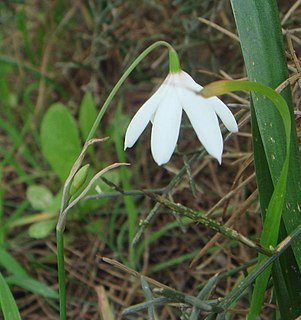
Acis trichophylla is a species of flowering plant in the family Amaryllidaceae, native to Portugal, Spain and Morocco. It has very narrow leaves. The flowers are produced in late winter or early spring and are usually white, but sometimes pink-tinged or all pink. The species is cultivated as an ornamental bulb, but requires protection from hard frost.

Dierdré "Dee" Anne Snijman is a South African botanist and plant taxonomist who is notable for studying and writing extensively on bulbs. She has described over 120 species and has written comprehensive works on South African flora. She received the 1997 Herbert Medal from the International Bulb Society for her research on Amaryllis.














